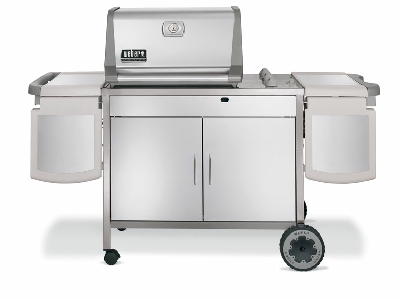|


|
Weber
Grills
All around this is one
of the best gas grills on the market for it's price. Take care of
it and a Weber Gas Grill will last you for decades and give you
the versatility you want to grill most anything you can think of.
The high quality parts, particularly the stainless steel burners
are built to last. Not only are they built to last they look great
too.
What to look for in a gas grill
Besides price, what separates an ordinary gas grill from
a great gas grill? Here are a few points savvy grill shoppers should
know.
The Elements of a Gas Grill
The basic underpinnings of a gas grill are really quite simple:
First come burners to create heat. Above them you'll find some type
of system to disperse the heat from the burners (Flavorizer bars,
ceramic briquettes, lava rock, etc.). Above those lie the cooking
grates. Let's look under the hood to get a better sense of what
you should be looking for.
The Cooking System
Better grills generally have two or more separate burners (not just
control knobs) which allow greater control of heat. Most lower-priced
grills have only one burner shaped like an H or a bar, some with
one control, some with two controls. Grills with one burner don't
allow you to control heat as well as grills with multiple burners
and may result in hot and cold spots on the cooking surface.
When cooking on a gas grill, juices from the food drip down and
accumulate near the heat source until they reach a flash point and
burn off. The best systems quickly flash the drippings, eliminating
flare-ups and creating flavorful smoke. Most manufacturers rely
on lava rock or ceramic briquettes to distribute the heat from the
burners to the cooking surface. Drippings from the food tend to
pool in these systems causing undue flare-ups. The best grills use
a steel bar system (pioneered by Weber) that funnels the grease
away from the burner flames, greatly reducing flare-ups.
BTUs (British Thermal Units)
BTUs are not a measure of cooking power. They indicate the volume
of gas a grill can burn. Tightly engineered grills use fewer BTUs
and cook food more efficiently. Sometimes less is more. Too many
BTUs can cause damage to burners and reduce the life of the grill.
In general, large grills with large cooking surfaces require higher
BTUs.
Solid Construction
A good, well-built grill will feel solid and sturdy; a poorly made
grill will wiggle. If a grill isn't solid on the sales floor, chances
are it will fall apart rather quickly on the patio or deck. Choose
a grill made of high grade U.S. steel. Also opt for a baked-on,
porcelain-enamel finish. The cart should be sturdy, wheels should
roll easily, and the grill should display a good fit and finish.
Cooking grates are generally made from heavy-duty plated steel or
chrome-plated aluminum. A thicker, heavier-gauge cooking grate will
last longer and distribute and retain heat better. Grates coated
with porcelain enamel are a common step-up feature. The best grates
are made of cast iron, stainless steel, or porcelain-coated aluminum
or cast iron.
Assembly
When you buy a barbecue, you want to grill, not drill, so fast and
easy assembly is a priority. Some grills require hours (and an engineering
degree) to assemble. Better brands reduce or eliminate the amount
of assembly required by the consumer.
Service & Maintenance
Top-notch after-market service supports any quality made grill,
including thorough, easy-to-read information about the product,
and a toll-free service line. A good grill is easy to clean and
to maintain, and long-life is assured by easy access to replacement
parts and service through a well-established servicing dealer network.
Safety
A good grill lights effortlessly, controls heat easily, has handles
that stay cool to the touch, and has added safety features.
Long Warranty
It makes sense: the best manufacturers can afford to stand behind
their products.
Added Conveniences
Optional side burners are great for cooking sauces and other dishes.
Flip-up side tables give you extra space for food preparation.
|


